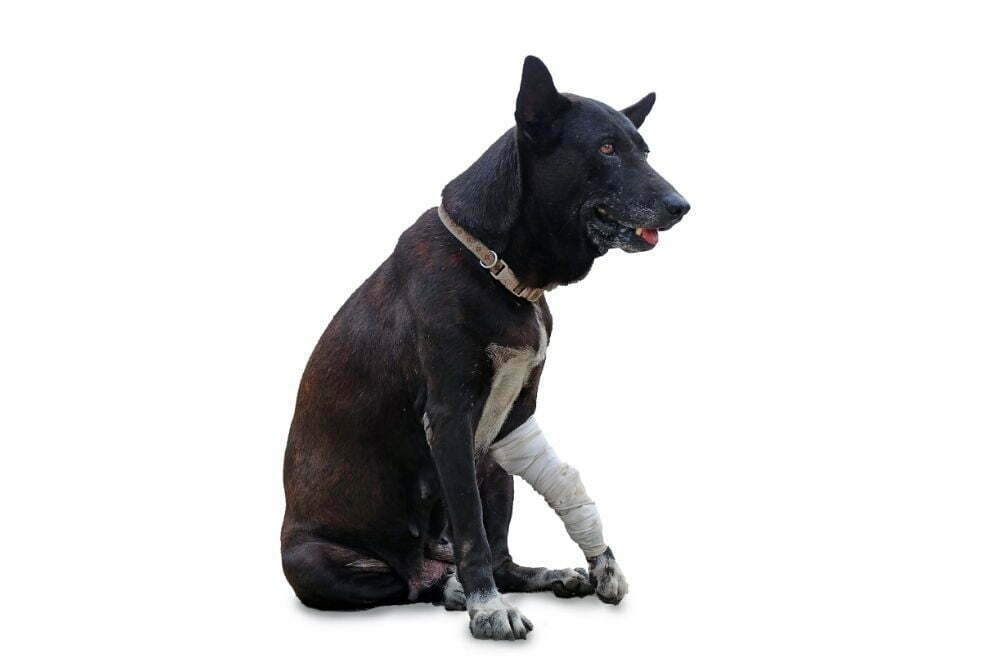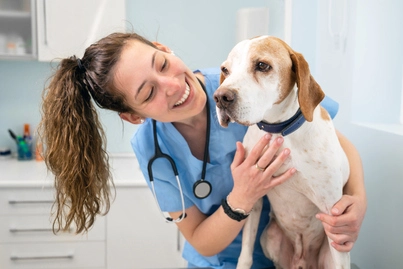Dog owners know that their pet becomes part of the family and you love them like a blood relative. Unlike humans, dogs cannot verbalize how they feel, and it can be difficult to ascertain when something is wrong.

Dogs are known for their abundant energy levels and are always running about and jumping off things. This is very normal for dogs, and they should be playing if they are healthy and well. The only problem is that this can lead to them injuring themselves. It is not easy to know when animals are hurt, and leaving injuries untreated can lead to much more serious problems.
This guide will tell you the 5 main signs that your dog’s injury may be caused by a broken bone. None of this advice should replace that from a qualified professional. If you are concerned about your dog’s health and wellness, we strongly advise taking them to a veterinarian for a health check.
Connect with a verified veterinarian in minutes. No waiting for appointments or office hours. No high fees. Your pet's health made convenient and worry-free.
What bones do dogs have in their legs?
A dog’s front legs are made of 3 bones – the radius, ulna, and humerus. The radius is the weight-bearing bone in the leg. The radius and ulna are in the lower leg, and the humerus is what forms the shoulder and elbow.
Your dog’s back legs are made of a different set of 3 bones. These are the tibia and fibula, which form the shin, and the femur bone, which is in the thigh area.
What are the types of broken bones?
As with humans, breaks in dog bones are known as fractures. There are 7 main types of break – incomplete, complete, transverse, oblique, comminuted, open, and closed fractures.
Complete and incomplete fractures refer to how far around the bone the break has spread. A complete fracture has split the circumference of the bone, whereas an incomplete fracture only appears part of the way around the bone.
A transverse fracture is one that appears straight across the bone, and oblique fractures lie diagonally on the bone. A comminuted fracture is where the break is in 3 or more sections.
Open and closed fractures refer to the layer of skin, fat, and subcutaneous tissue around the bone. If the broken bone has split the skin, then it is known as an open fracture. If there is no visible wound at the fracture site, then it is closed.
If the fracture is particularly serious, then there is every chance there are deeper issues at play too. Serious trauma can cause critical and life-threatening injuries such as internal bleeding, clots, and organ damage. These problems are not necessarily known without a full once-over from a qualified professional but could become fatal if left untreated.
Sign 1: Swelling
As with any injury in humans, damaged areas of your dog’s body will appear swollen. Swelling is an inflammatory response and is the first step to be taken in the healing process.
As the injury settles, tissue fluid and white blood cells rush to the area. The excess blood that is drawn to the area is the reason for the swelling and heat in the area. The swelling prevents your dog from putting weight on their injured limb, helping to prevent further trauma.
Swelling commonly indicates the presence of a closed fracture.
Sign 2: Whining and howling
Dogs cannot talk to humans to communicate, so they must find alternate methods. One of the ways your dog will indicate that they are in pain is by whining, whimpering, and howling. You will be able to clearly tell the difference between normal sounds and pained whimpers. If you hear upset noises, you should check on your dog.
Sign 3: Bruising
As well as swelling, if the break is bad, you may notice a bruise appearing. If it turns purple, this is an indication that the break is severe.
In very bad breaks, you may even see the bone breaking through the skin. This is an open fracture.
Sign 4: Behavioural changes
You will know the normal ways in which your dog acts towards you. If they are normally calm and friendly but are suddenly aggressive, this is likely because they are experiencing pain. Another clear sign that something is wrong is if your dog suddenly loses their thirst or appetite.
Sign 5: Holding the limb awkwardly
Your dog will not be able to walk normally on their leg if it is broken. They may be limping or holding their leg awkwardly as they walk. You may also notice them holding their leg up weirdly as they are lying down.
They are likely to not want to put any weight at all on the limb, suggesting an open or closed fracture. Their legs may be hanging freely but at a strange and unnatural angle when sitting or lying. Again, this indicates an open or closed fracture.

Can a dog’s broken leg heal on its own?
Yes, a dog’s broken leg can heal on its own, but we do not advise this route of action. Without medical intervention, there is a high chance that the bone will set in an odd direction or improperly. This could lead to much more serious complications down the line.
If you suspect your dog has a broken leg, then you should take them to the veterinarian. They will ensure that the bone is set in the correct position and give your dog an overall health check to ensure there are no further issues.
Can a dog walk on a broken leg?
There is no clear answer to this. It all depends on the location and the severity of the injury. Often they will be able to walk to some degree, even with a broken bone.
Should I take my dog to the vet if he is limping?
This depends on how serious you feel the limp is. Many dogs will limp regardless of how much pain they are in. This means that if you notice a slight limp, the vet should not necessarily be your first port of call.
Of course, if you feel as though your dog is in pain or something more serious is afoot, please take them to a veterinarian for a health check.
How much does it cost to treat a dog’s broken leg?
This varies according to the severity of the break and the treatment plan that your vet thinks is most suitable. Some serious fractures will require a surgical procedure to help with the healing process. These procedures commonly take between 1 and 3 hours to perform.
This is commonly either an external fixing or internal fixing. External fixing sends screws through the bone fragments, skin, and body tissue. These connect to a metal bar on the exterior of the leg. This method tends to be used on complex fractures.
Internal fixing refers to a system where the screws remain inside the limbs. They are used to connect the bone fragments to one another or to a metal plate inside the leg. This is often used in torso, spine, and head fractures.
Surgical fracture repair is a very costly procedure. This is because it takes a long time, requires specialist equipment, and has a long period of aftercare. Base prices for this kind of treatment start at around $2,000. If the break is particularly severe, your dog is old, or you run into any kind of complications, this price can increase exponentially.
It is a good idea to purchase pet insurance when you first get your dog. It may seem pointless, but when something goes wrong, you will be so grateful you purchased it.
How should you transport a dog with a suspected broken bone?
If your dog is not already lying down, you should encourage them to lie down. If they are incredibly reluctant, do not force them. This could imply that they are in elevated pain when lying down.
As uncomfortable as it may be for you as a dog owner, we recommend muzzling your dog. No matter how placid their normal demeanor is, when a dog is in pain, they may bite you out of fear. We recommend slipping a muzzle or makeshift muzzle over their snout to prevent them from hurting you. A gentle pressure on the snout may also help to calm your dog slightly.
It is very important that you transport your dog with care when a broken bone is suspected. If they have suffered any kind of serious trauma, then there is a high chance that there could be internal bleeding or injuries. You should move them into the car as carefully as possible and try to keep them still.
How will a vet diagnose a broken bone?
Your veterinarian is likely to administer an intravenous drip. This will help them to give your dog fluids, pain management medication, or antibiotics as required. They will likely also catheterize your dog. This allows them to pass urine without needing to stand up, potentially aggravating their injuries.
The vet will then check your dog for signs of trauma and organ damage. They are likely to perform some blood tests at this time. They will often then be sedated. This allows the vet and their team to perform radiographs of your dog. This will let them check the bones for breaks and will ensure there are no complications with the heart and lungs. They may also offer an abdominal ultrasound to check the organs.
The severity of the fracture will dictate the treatment plan offered by your vet. As with broken bones in humans, sometimes your dog’s limb will be put into a cast. More serious fractures may be treated by attaching pins, screws, and plates to the bone to ensure it will heal correctly.
How can I support my dog’s recovery?
The most important thing is that you do not force your dog out on walks too early on in the recovery process. Wait until they have begun to put weight on the injured limb of their own accord. At this point, you can consult your veterinarian to evaluate whether your dog is ready to go out on short walks.
To make the home recovery process easier on your dog, we recommend keeping them in one room or area of your house. This will minimize the distance that they are forced to move and will help to prevent them from walking on their broken bone. We recommend keeping them in an area with carpets as this reduces the strain and pressure on their limbs.
We do not advise allowing your dog to walk upstairs or across slippery surfaces. If your dog likes to be kept near you and you need to switch rooms, we recommend carrying them.
Your vet is likely to give your dog some kind of NSAID for pain management. These are non-steroidal anti-inflammatory drugs, similar to ibuprofen and aspirin. You should only give your dog drugs that have been provided by the vet, do not be tempted to give them over-the-counter human pharmaceuticals. These can be potentially harmful to your dog.
You should put a collar on your dog. This will prevent them from licking or chewing on the injured site and the dressing. This can lead to serious complications and an extended recovery period.
You will need to regularly change and replace your dog’s bandages. This will help to keep the wound site clean and prevent any infections from taking hold. Your vet is likely to ask you to attend follow-up visits where they will replace the dressings, but you should be changing these in-between visits.
You are likely to need to attend physiotherapy sessions to encourage the healing of your dog’s bone. This will ensure that they retain a range of mobility and will be able to use their limbs normally when the bone has recovered.
How long does it take for a dog’s broken leg to heal?
As with humans, this varies according to a variety of factors. The age of the dog is one of the most important. Younger dogs and puppies will heal much more rapidly and can be back to their old selves in as little as 2-4 weeks. This is because there are a lot more stem cells present in puppies, and this allows them to grow and repair more quickly.
For older dogs, it is likely to take closer to 8-12 weeks for a broken bone to heal. The severity of the break will also take a toll on how long the fracture will take to repair.

